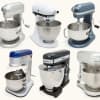With Whipped Cream, Temperature Matters
Conventional wisdom says to make sure your cream is cold before whipping it, but we wondered exactly how much temperature matters, so we decided to run a few tests.
EXPERIMENT
We whipped three batches, each consisting of 1 cup of whipping cream, to stiff peaks: one that came straight from the refrigerator and was 40 degrees; another that had sat out for 1 hour and reached 57 degrees; and a third that was at room temperature, 72 degrees. We recorded how long it took to whip the cream to its maximum volume without overwhipping and noted the final texture.
RESULTS
The refrigerated sample yielded 2 1/4 cups of smooth, stiff peaks after 1 1/4 minutes of whipping. The sample that sat out for an hour yielded 2 cups of slightly grainy stiff peaks after 1 minute and 50 seconds of whipping, and the room temperature sample yielded 1 3/4 cups of grainy whipped cream but never reached stiff peaks, even after 2 1/2 minutes of whipping.
72 DEGREES
Yield: 1 3/4 cups
Time: 2 1/2 minutes
57 DEGREES
Yield: 2 cups
Time: 1 minute, 50 seconds
40 DEGREES
Yield: 2 1/4 cups
Time: 1 1/4 minutes
EXPLANATION
Whipping cream introduces air bubbles. When the cream is cold, these bubbles are held in place by a network of tiny globules of solid fat, which allow the cream to eventually expand into a light, airy mass. At warmer temperatures, that fat starts to soften and the globules collapse, so the cream can’t whip up as fully, and it takes longer to reach its maximum (diminished) volume. This extended whipping time also gives the cream a grainy texture, as the fat forms small, irregular clumps rather than microscopic, smooth solid globules that surround the air bubbles.
TAKEAWAY
For maximum volume and the best texture, it’s crucial to use cream straight from the refrigerator. Chilling the bowl and beaters can also help ensure that your cream stays cold through the whipping process.

